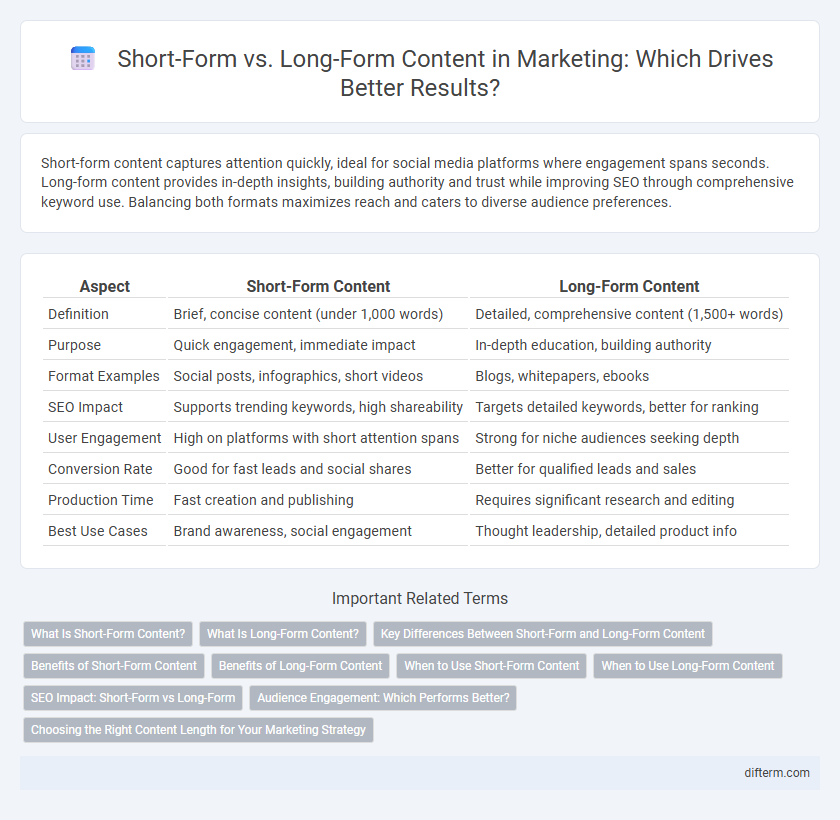Short-form content captures attention quickly, ideal for social media platforms where engagement spans seconds. Long-form content provides in-depth insights, building authority and trust while improving SEO through comprehensive keyword use. Balancing both formats maximizes reach and caters to diverse audience preferences.
Table of Comparison
| Aspect | Short-Form Content | Long-Form Content |
|---|---|---|
| Definition | Brief, concise content (under 1,000 words) | Detailed, comprehensive content (1,500+ words) |
| Purpose | Quick engagement, immediate impact | In-depth education, building authority |
| Format Examples | Social posts, infographics, short videos | Blogs, whitepapers, ebooks |
| SEO Impact | Supports trending keywords, high shareability | Targets detailed keywords, better for ranking |
| User Engagement | High on platforms with short attention spans | Strong for niche audiences seeking depth |
| Conversion Rate | Good for fast leads and social shares | Better for qualified leads and sales |
| Production Time | Fast creation and publishing | Requires significant research and editing |
| Best Use Cases | Brand awareness, social engagement | Thought leadership, detailed product info |
What Is Short-Form Content?
Short-form content includes brief, engaging pieces such as social media posts, infographics, and short videos typically under 1,200 words or 2 minutes in length. This format captures audience attention quickly, making it ideal for brand awareness and driving immediate engagement in fast-paced digital environments. Marketers leverage short-form content to boost reach, encourage sharing, and deliver concise messages that resonate with mobile-first consumers.
What Is Long-Form Content?
Long-form content is an in-depth piece typically exceeding 1,200 words that thoroughly explores a topic, offering detailed insights, data, and examples to engage audiences and improve SEO rankings. It provides comprehensive value by addressing multiple facets of a subject, which enhances user experience and increases the likelihood of backlinks and social shares. Brands often use long-form content such as extensive blog posts, whitepapers, and guides to establish authority and drive sustained organic traffic over time.
Key Differences Between Short-Form and Long-Form Content
Short-form content typically ranges from 300 to 800 words, focusing on quick consumption and immediate engagement, making it ideal for social media and email marketing. Long-form content, usually exceeding 1,200 words, provides in-depth information, enhancing SEO through greater keyword density and higher dwell time. The key differences lie in their purpose, with short-form content driving quick interactions and long-form content building authority and detailed understanding.
Benefits of Short-Form Content
Short-form content drives higher engagement rates by delivering concise, impactful messages that capture audience attention quickly, essential for platforms like Instagram and TikTok. It offers faster production turnaround and greater versatility across multiple digital channels, maximizing brand visibility and campaign reach. Enhanced shareability and easier consumption boost viral potential, making short-form content a key asset in modern marketing strategies.
Benefits of Long-Form Content
Long-form content enhances SEO by providing comprehensive information that increases keyword diversity and dwell time, boosting search engine rankings. It establishes authority and trust with audiences through detailed insights and thorough analysis, improving lead generation and customer retention. In-depth content also encourages social sharing and backlinks, further amplifying brand visibility and domain authority.
When to Use Short-Form Content
Short-form content excels in capturing audience attention quickly on platforms like Instagram, TikTok, and Twitter where user engagement is brief and fast-paced. It effectively drives brand awareness, encourages immediate interactions, and complements campaigns needing rapid message delivery or timely promotions. Brands aiming to boost social media presence or generate leads through snackable, easily digestible pieces should prioritize short-form content for optimal results.
When to Use Long-Form Content
Long-form content excels in building authority and trust by providing in-depth information that addresses complex topics or detailed buyer journeys. It performs well in SEO by targeting multiple keywords and increasing dwell time, which boosts organic rankings. Use long-form content when your goal is to educate, nurture leads, or establish thought leadership within competitive markets.
SEO Impact: Short-Form vs Long-Form
Short-form content drives higher engagement and quicker indexing by search engines, boosting immediate SEO performance through concise keyword usage and shareability. Long-form content enhances SEO by providing in-depth coverage, increasing dwell time, and attracting quality backlinks, which improves domain authority and ranking potential. Balancing both formats leverages short-form's rapid reach with long-form's sustained organic growth for comprehensive SEO strategy.
Audience Engagement: Which Performs Better?
Short-form content drives higher audience engagement through quick consumption, shareability, and appeal to users with limited attention spans, outperforming long-form content on platforms like TikTok and Instagram. Long-form content excels in building trust and authority by providing in-depth information, making it ideal for audiences seeking detailed insights and fostering deeper connections. Marketers should leverage short-form content to boost immediate interactions while using long-form content to nurture long-term relationships and enhance brand loyalty.
Choosing the Right Content Length for Your Marketing Strategy
Short-form content excels in capturing immediate attention and driving engagement on social media platforms due to its concise and easily digestible nature. Long-form content provides in-depth information, building authority and improving SEO rankings through comprehensive keyword integration and detailed insights. Selecting the appropriate content length depends on your target audience's preferences, marketing goals, and the platform used to maximize reach and conversions.
short-form content vs long-form content Infographic

 difterm.com
difterm.com